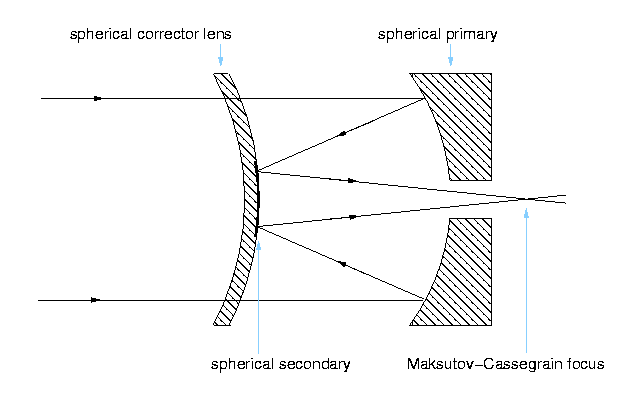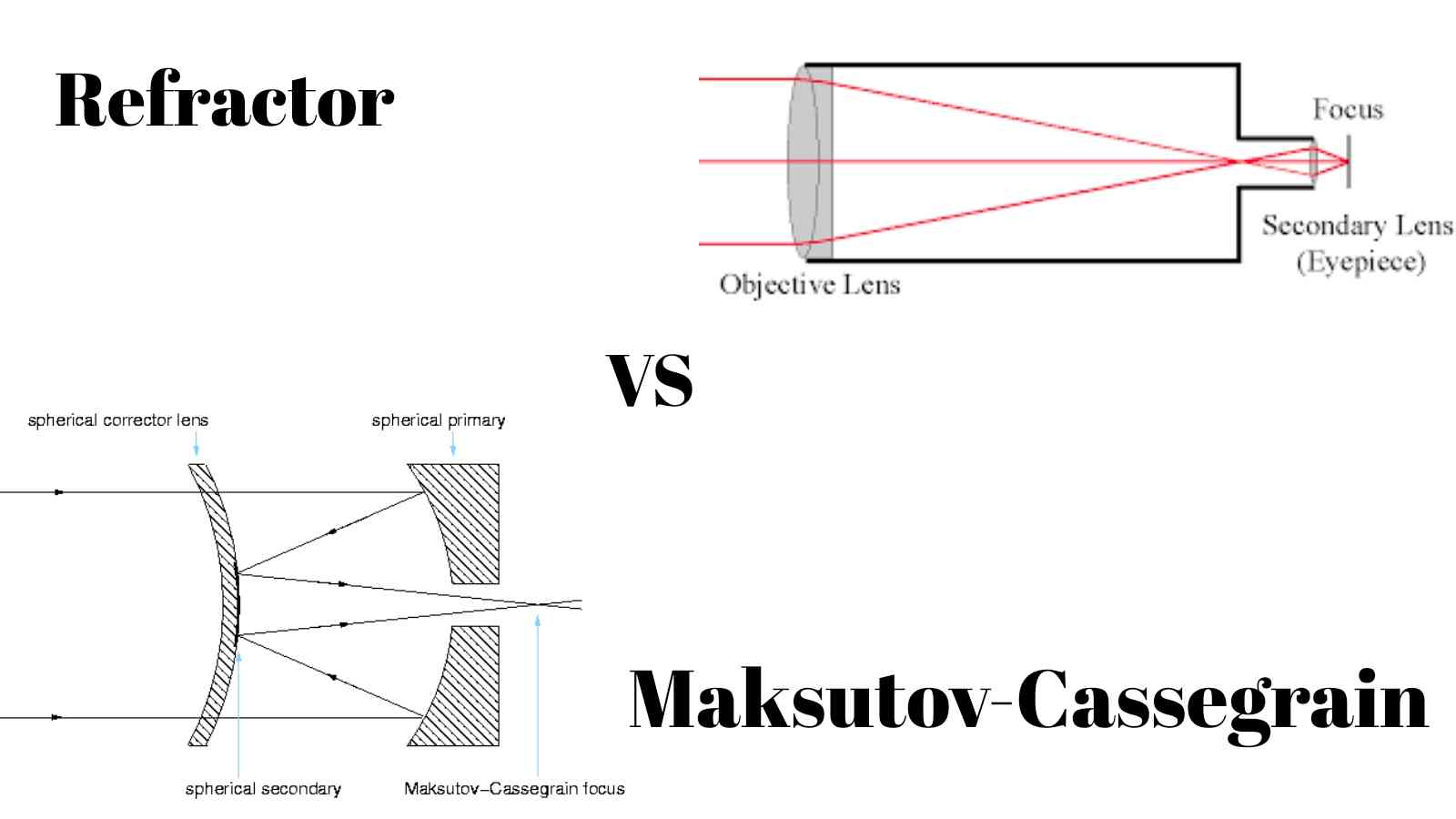*This post may contain affiliate links. This means we may make a commission if you purchase an item using one of our links*
If you’re new to the telescope game, understanding the different aspects of telescope can be really overwhelming, from what the mount, eyepieces, dew heaters, the optics of the telescope and so on. Trust me I know, brain can’t compute kind of situation as I was in the same position as you not too long.
Now getting into the topic at hand, the reason why you’re here is to figure what the difference is between the different optics in question namely the maksutov-cassegrain optics and refractor optics.
As a very simple explanation refractor telescopes utilise a glass objective lens which is found at the top end of the tube through which light passes through before reaching your eyes via an eyepiece. A maksutov-cassegrain (Make) telescope on the other hand is made up off both mirrors and a glass based lens with there being a glass based corrector lens called a meniscus corrector, a concave primary mirror near the base and a secondary convex mirror attached to the corrector lens.
The manner is which the mak is designed means that they tend to have focal lengths much larger than similar sized telescopes making them great for planetary viewing.
Of course throughout the rest of this article I’ll go into a lot more depth regarding both optical variations and the best use case scenarios for each.
What Is A Refractor Telescope?
Table of Contents

A refractor telescope is the oldest optical variation used within telescopes as it was made all the way back in 1733. Refractors can come in a few different variation from an achromatic doublet design to the far more expensive yet higher quality doublet and triplet apochromatic telescopes.
The achromatic optics are generally used within the more lower end telescope (for beginners) who mostly want to use their device for visual use and don’t really mind the visual imperfections that come with it such as chromatic aberration.
Apochromatic telescope however are reserved for the individuals looking for a much higher end experience and those who also want to really try out astrophotography.
The doublet and triplet variations have their differences (you can read this article for a more thorough breakdown) but as a whole, they’re far superior to achromatic devices as chromatic aberration and even spherical aberration is mostly fixed with these refractors.
Of course for the extra quality you will need to pay a premium, which in most cases is several times more than an achromatic device whilst in a lot of cases you’d need to purchase a mount too whereas achromatic based devices tend to come fully prepped with all the relevant equipment at a much cheaper price.
What Is Maksutov-cassegrain Telescope?

A Maksutov-cassegrain on the other hand is a sub variation of the cassegrain with the main difference being the corrector plate used within its chassis to correct the spherical aberration that is prevalent as a result of its primary mirrors design.
As I’ve mentioned already maksutov-cassegrain optics are made of both a glass lens and 2 mirrors, one being a spherical (concave) primary mirror and the other a convex secondary.
In regards to what the corrector plate is, it’s a meniscus corrector which is basically a very thick lens used that minimises chromatic and spherical aberration but, the thickness does also result in a few issues.
The biggest issue would have to be the time it takes a mak to achieve its optimal thermals for use outside. More often then not just getting the opportunity to observe stars with clear skies is quite tough to do so having to wait on your device to be usable, which could take 10 or so minutes, could be the difference between being able stargaze or being blocked by the clouds.
Although this isn’t as big an issue for smaller Maks, if you have a telescope 6 inches or larger, you should accept having to wait maybe 2 or 3 times longer for the device to be usable.
What Are The Differences Between A Maksutov-cassegrain Telescope And A Refractor Telescope?
The main differences between maksutov-cassegrain telescopes and refractor deceives are as such :
- Maks utilise both a glass lens and mirror whilst Refractors only use glass for their lenses
- Maks can have focal length around 5 – 7 times the length of the tube. This is due to the light passing through the lens and then bouncing of the 2 mirrors before entering the eyepiece
- The longer focal length makes maksutov-cassegrain telescopes far better for planetary viewing
- Achromtic refractors suffer from chromatic aberration whilst Maks don’t (this is due to the thick glass used)
- Apochromatic Refractors are better suited for astrophotography due to the crystal clear images and lack of any major visual issues.
- Maks are better at observing faint object/celestial objects
- Maks take longer to reach optimal temperatures for use due to the thicker glass implemented
- Refractors are far better for wider field of view visuals
- Refractor devices at higher aperture levels with the same aperture are better quality than Maks as contrast levels are superior whilst image quality won’t be quite as diluted due to the light reaching the eyepiece in a singular motion.
- The secondary mirror on maks can also obstruct the view as it is placed in the middle of glass lens whilst refractors don’t have any visual obstructions.
Of course there are some similarities between both optics such as them both being enclosed in their respective tubes unlike reflectors and using glass optics within their respective tubes. But, as you can see there are far more differences than similarities between the two optics.
Summary
Maks and refractor do have a fair bit of differences however, these differences don’t necessarily translate to either optical variation being significantly superior to the other.
A normal refractor device is generally cheaper and do tend have better contrast over Maks but they also do suffer quite heavily from chromatic aberration.
On the other hand the longer focal lengths of a Mak makes it better for viewing singular objects but, due to the light being diluted a Mak with a larger aperture than a refractor isn’t necessarily going to provide sharper views.
Lastly, apochromatic refractor (mainly triplet based one’s) will be much better for astrophotography even if Maks are reasonably competent at this too.
The general opinion by most is that Maks are competent telescopes and also very compact in comparison to reflectors and refractors, which is why they’re more expensive when looking at smaller aperture telescopes.
However, when you start looking into the larger aperture devices, a refractor is often regarded to be the better option even if they will be significantly larger in size than the equivalent aperture Mak.


